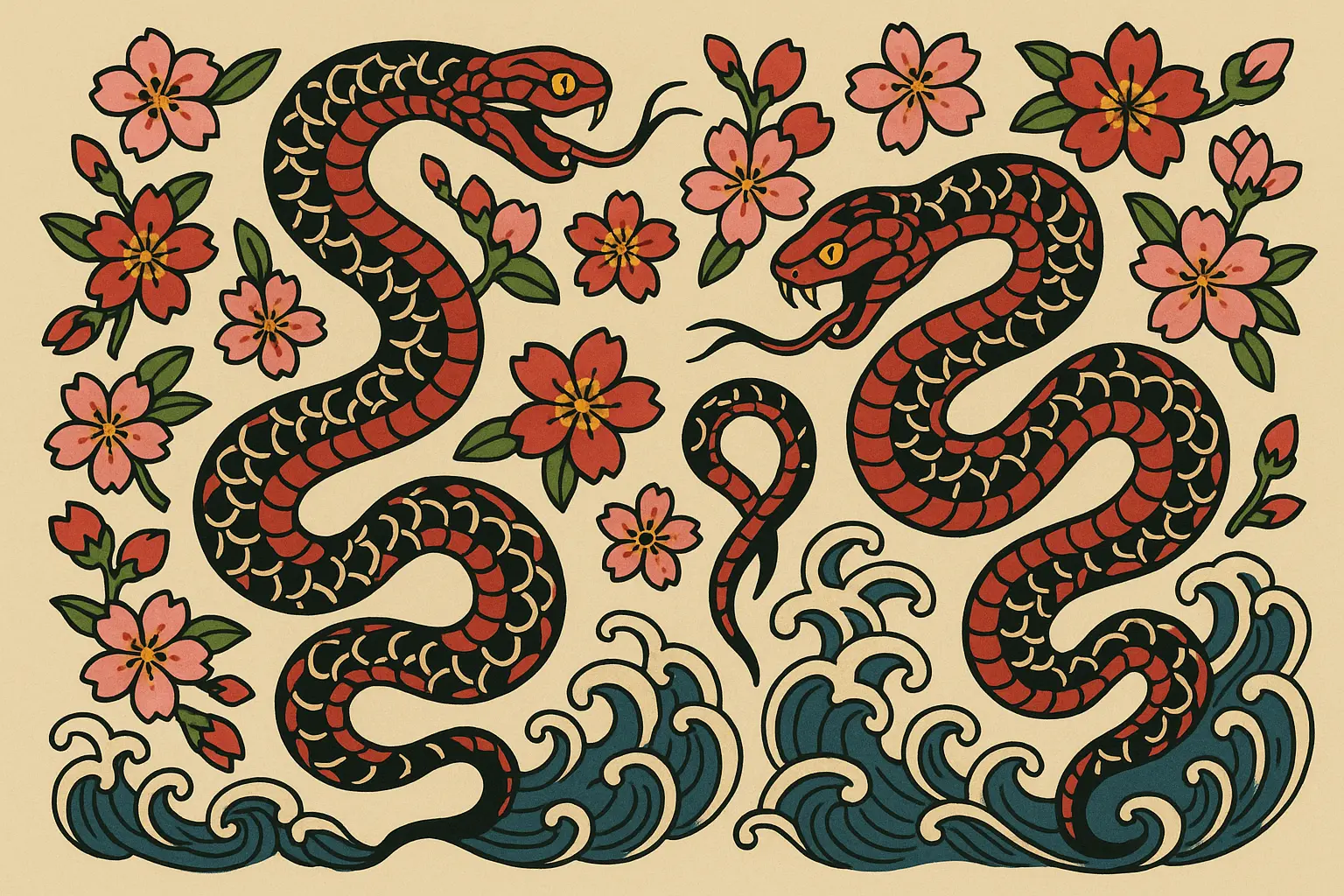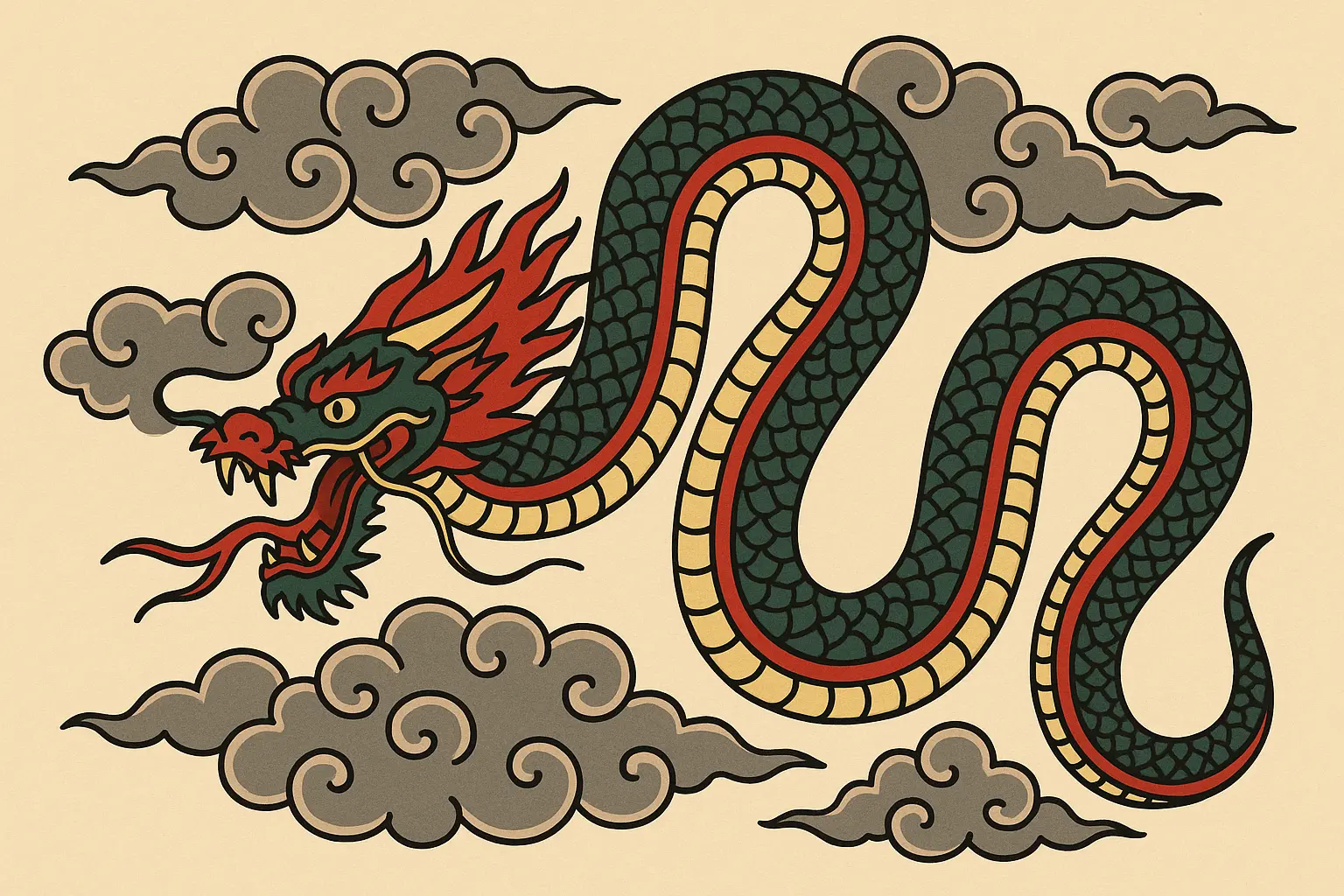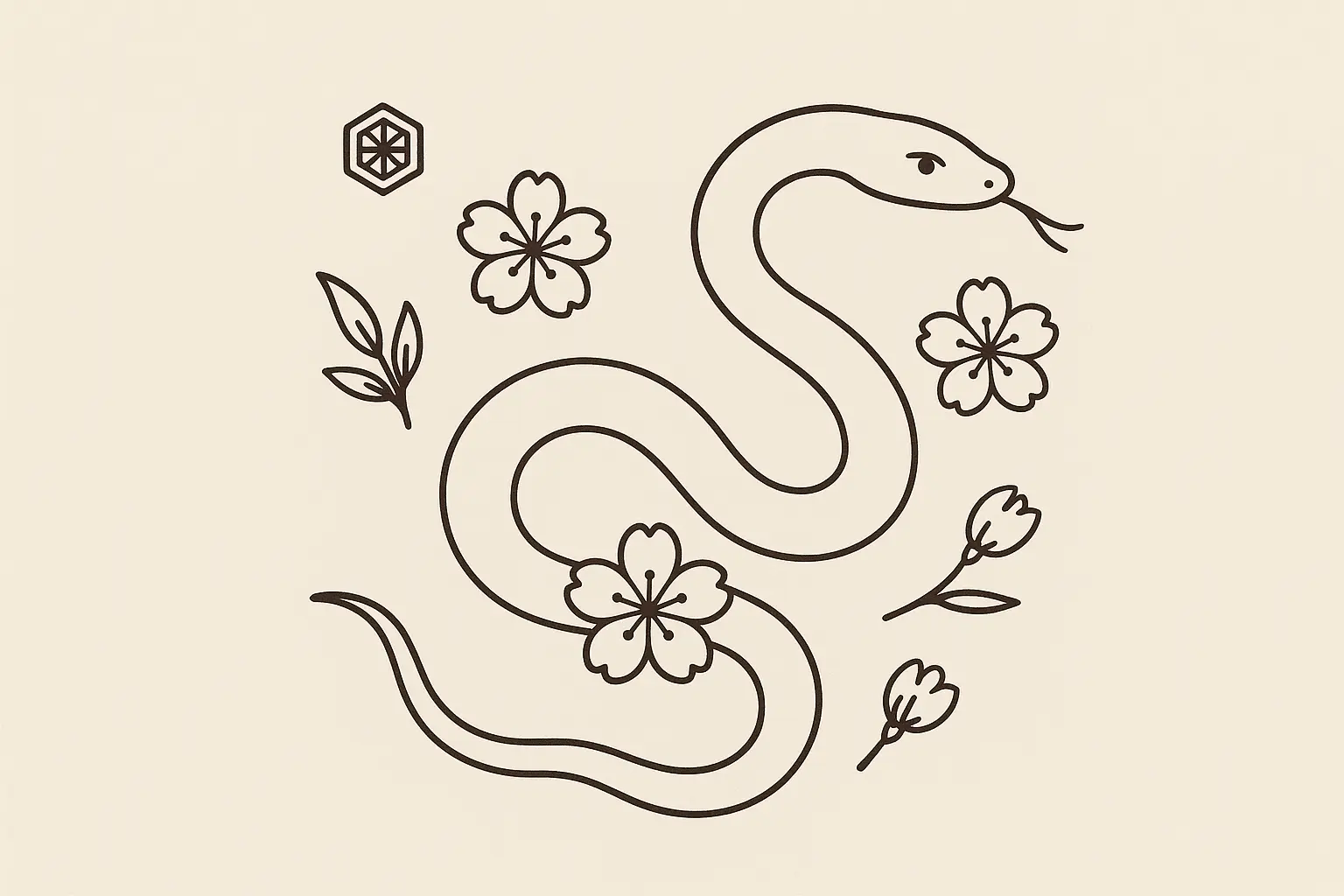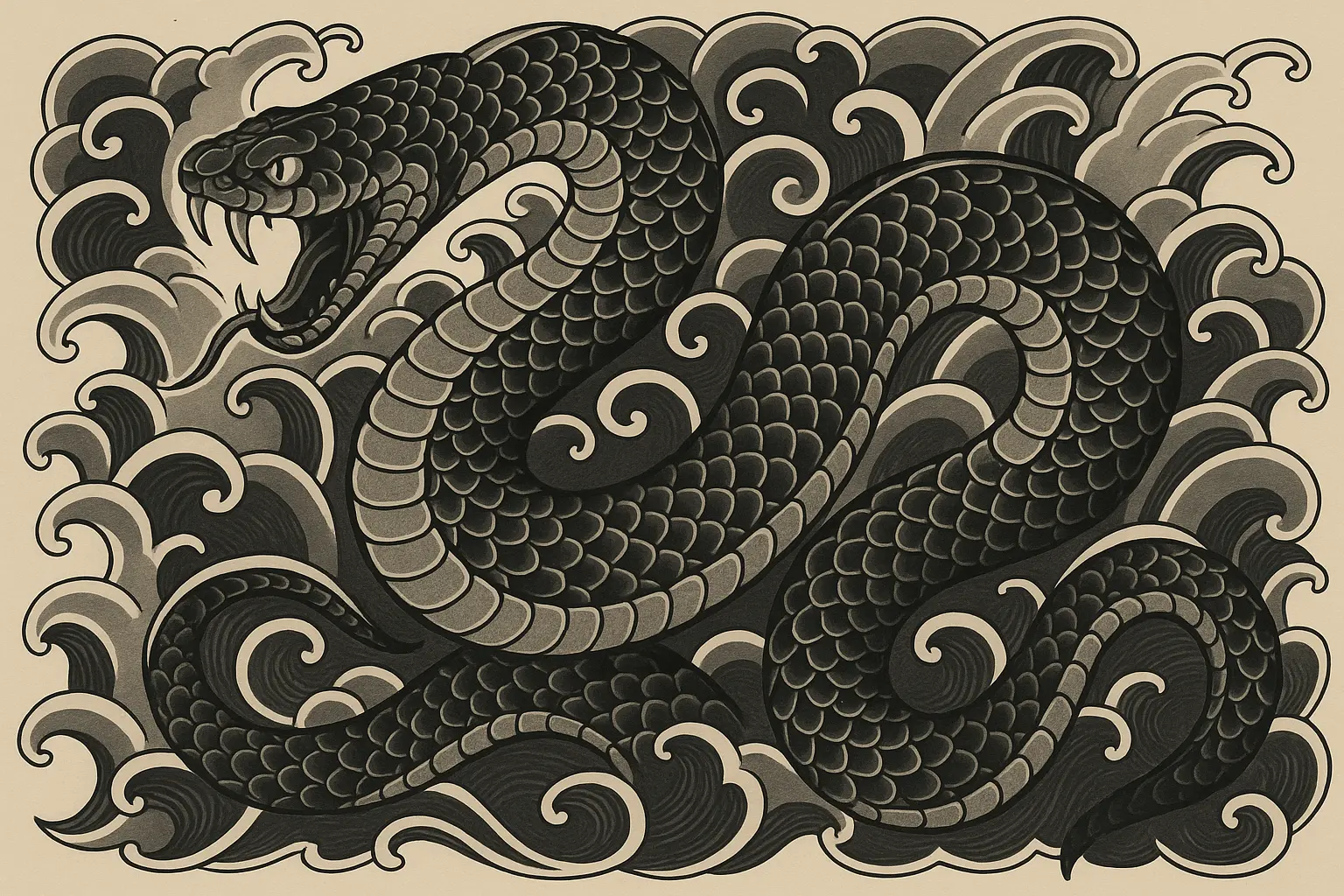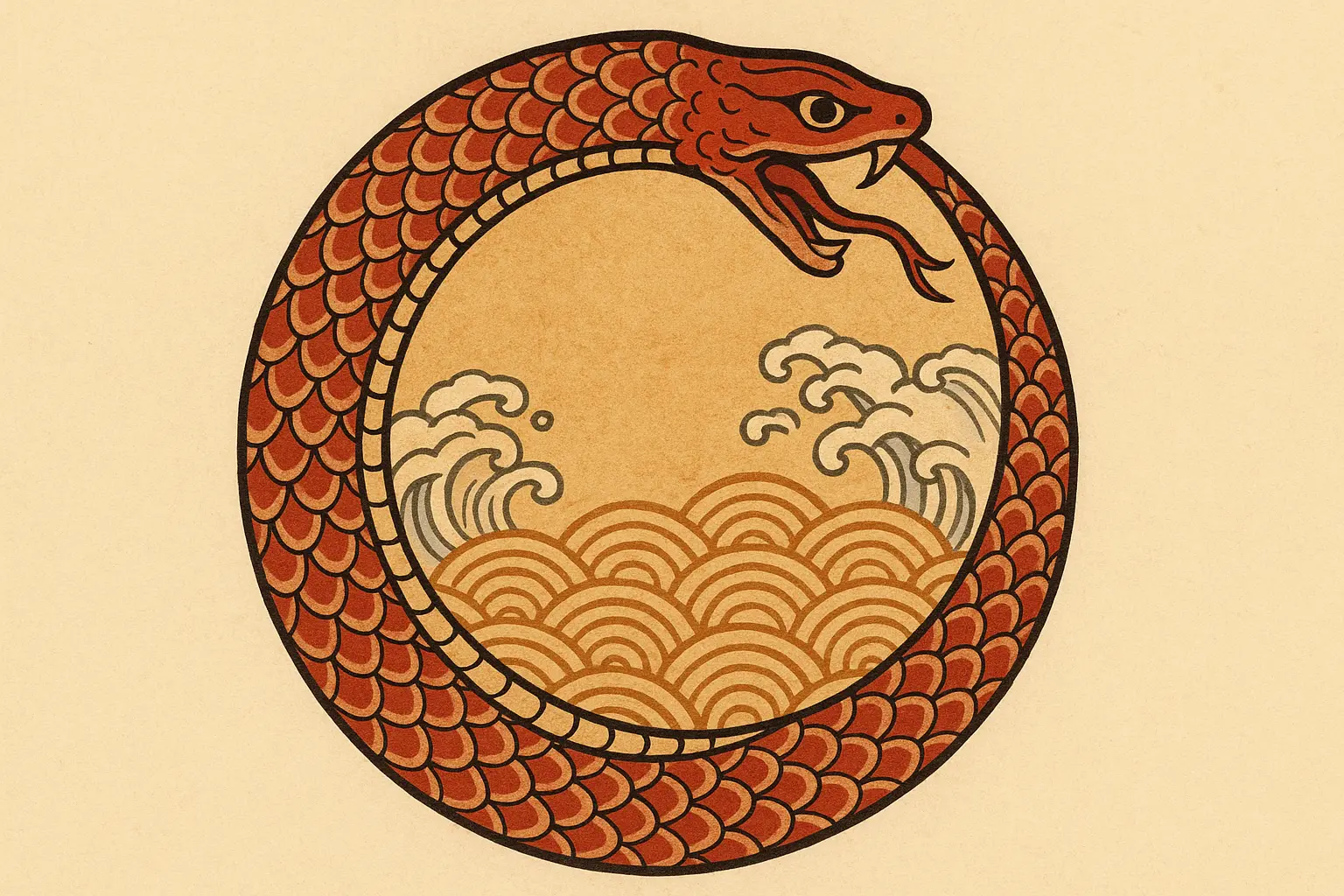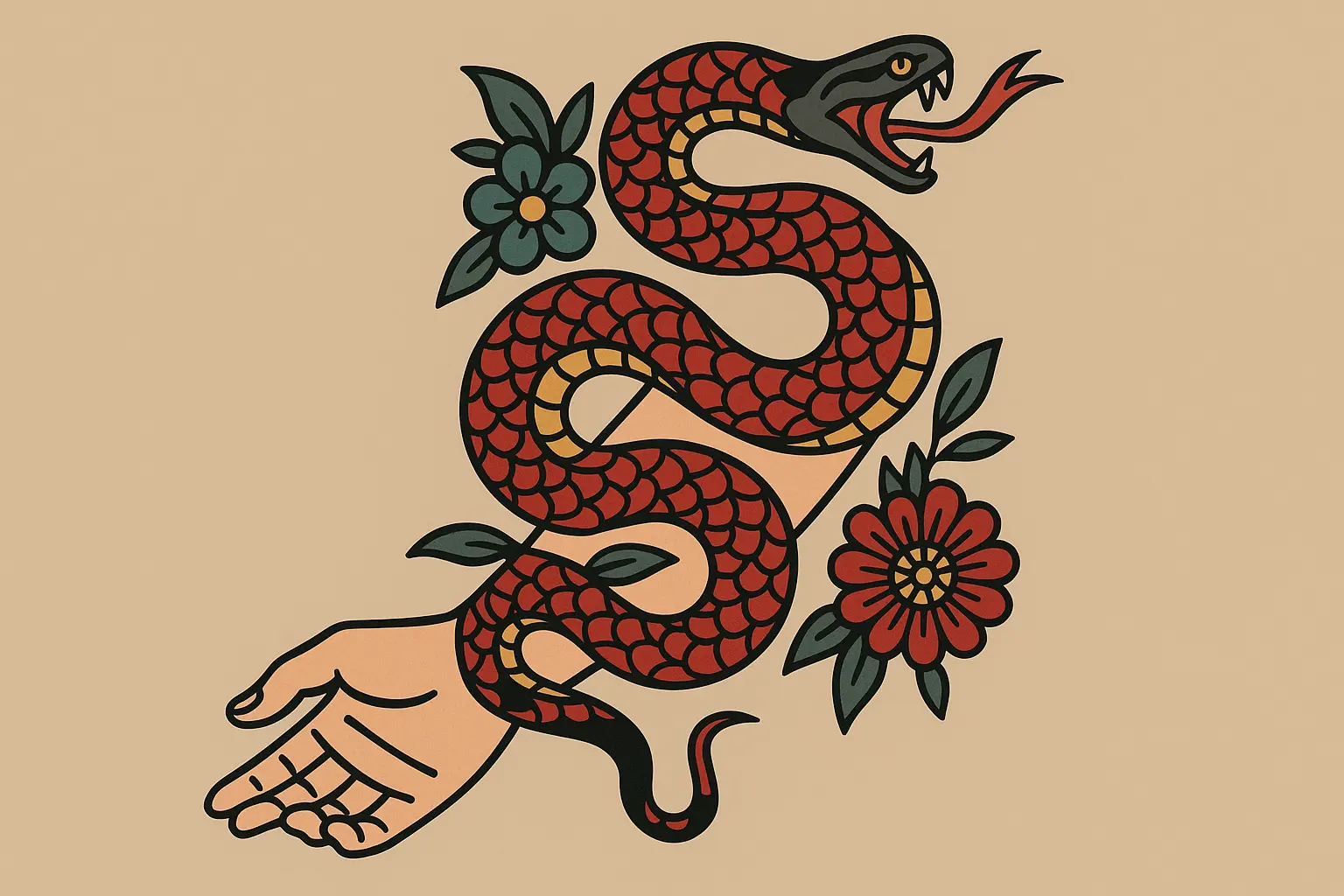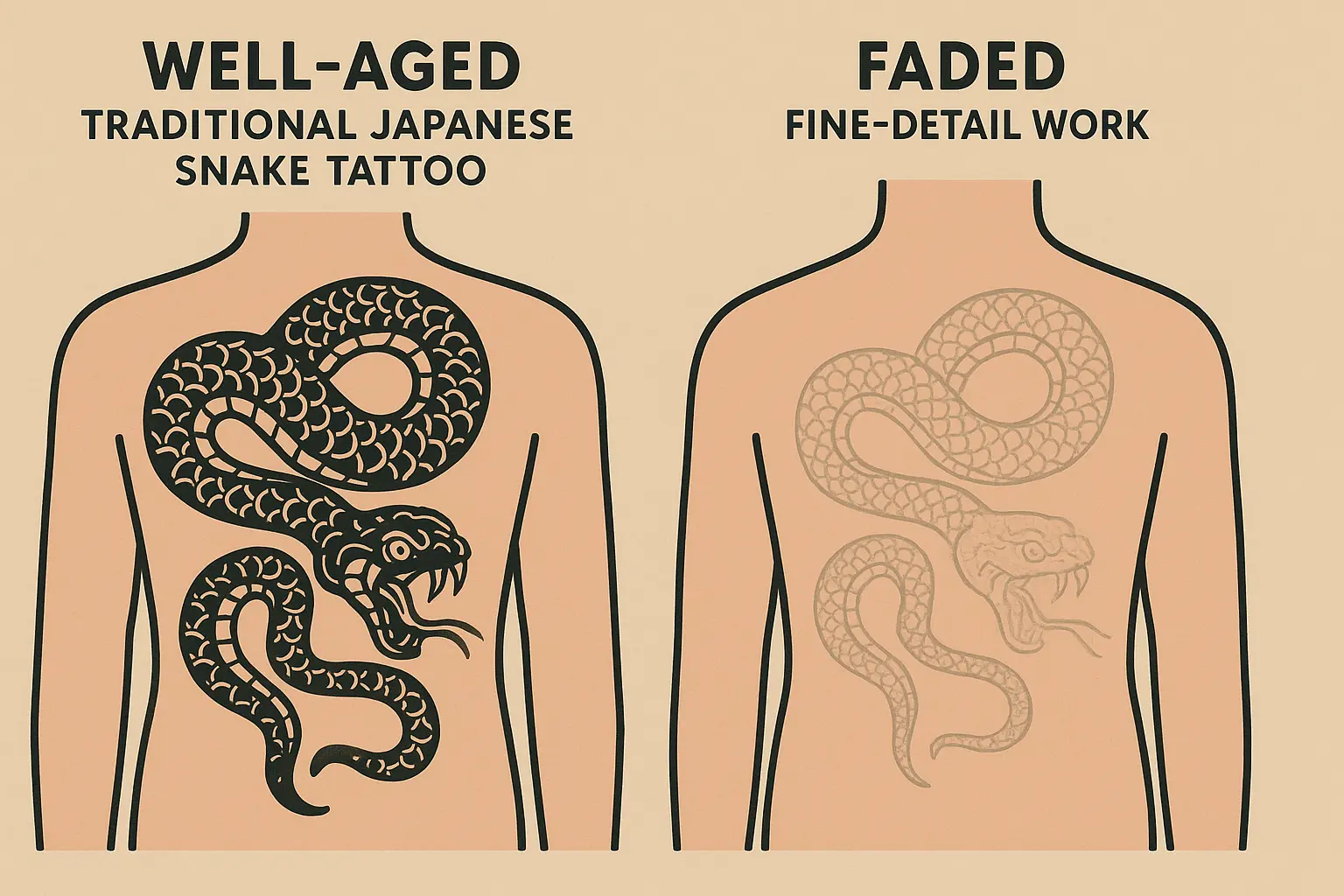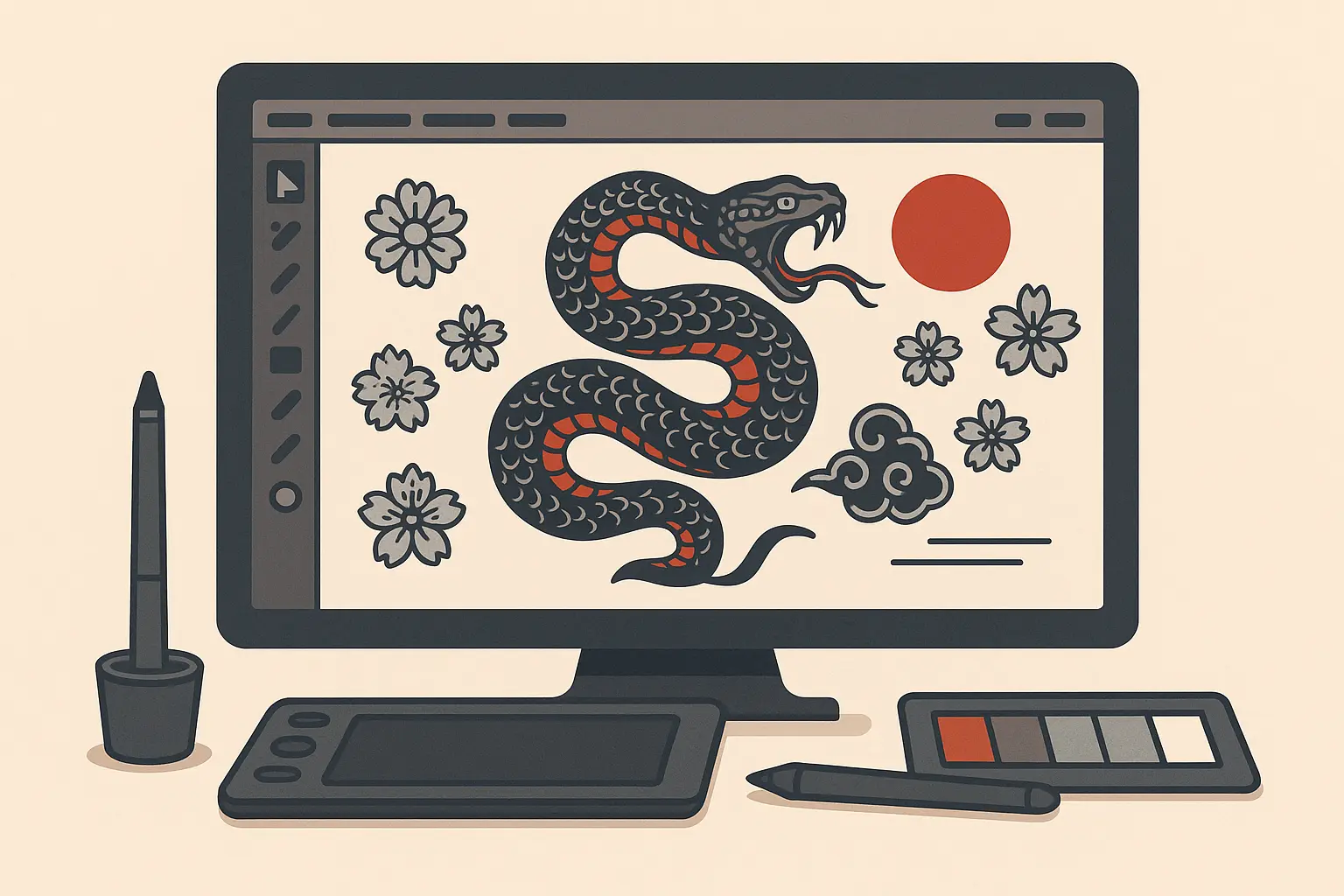25 Stunning Japanese Snake Tattoo Designs That Will Transform Your Body Art Journey

I remember scrolling through tattoo galleries years ago, completely mesmerized by the flowing lines and deep symbolism of Japanese snake designs. According to Sunset Tattoo, “The snake (Hebi) in Irezumi holds deep meaning in Japanese culture and folklore. It is seen as a symbol for protection, transformation and rebirth.” That moment sparked my fascination with how these serpentine masterpieces blend ancient wisdom with stunning visual impact.
Look, I’ve spent countless hours researching these designs, and I’m genuinely excited to share what I’ve found. We’re going to dive into 25 amazing Japanese snake tattoos that range from jaw-dropping traditional pieces to sweet little designs you could get on your lunch break. Whether you’re drawn to traditional irezumi techniques or modern interpretations, this comprehensive guide will help you navigate the cultural significance, artistic requirements, and practical considerations that make these tattoos so compelling.
Table of Contents
-
Essential Considerations Before Choosing Your Japanese Snake Tattoo
-
Traditional Irezumi Snake Designs (Designs 1-5)
-
Neo-Traditional Japanese Snake Interpretations (Designs 6-9)
-
Black and Grey Japanese Snake Artwork (Designs 10-13)
-
Small and Delicate Japanese Snake Designs (Designs 14-17)
-
Japanese Snake and Flower Combinations (Designs 18-21)
-
Arm-Specific Japanese Snake Designs (Designs 22-25)
-
How These Designs Address Your Key Concerns
-
Bringing Your Vision to Life with Professional Tools
-
Final Thoughts
TL;DR
-
Japanese snake tattoos (Hebi) symbolize transformation, protection, wisdom, and rebirth in traditional culture
-
Authentic designs require understanding of irezumi principles, proper placement, and skilled artists
-
25 designs span six categories: traditional, neo-traditional, black/grey, small/delicate, flower combinations, and arm-specific
-
Traditional designs age best due to bold lines and solid colors, while modern interpretations offer flexibility
-
Cultural respect and authenticity should guide your design choices to honor Japanese artistic heritage
-
Placement considerations range from full sleeves requiring master-level artists to small discrete designs
-
Professional design tools can help visualize concepts and communicate effectively with tattoo artists
Essential Considerations Before Choosing Your Japanese Snake Tattoo
Before committing to a Japanese snake tattoo, you need to evaluate several crucial factors that will impact both your immediate satisfaction and long-term happiness with this significant investment. Understanding tattoo pain levels for your chosen placement can help you prepare mentally and physically for the process.
I’ll never forget walking into my first tattoo consultation. My palms were sweaty, I had a Pinterest board with 47 different snake designs, and I had absolutely no idea what I was doing. The artist took one look at my chaos and said, “Let’s talk about what this tattoo actually means to you.” That conversation changed everything.
Five critical factors determine your satisfaction with a Japanese snake tattoo: cultural significance and meaning, style authenticity within irezumi tradition, placement and size requirements, artist expertise needs, and long-term aging characteristics. Understanding these elements ensures your tattoo honors tradition while meeting your personal goals and lifestyle requirements.
Cultural Significance and Meaning
Japanese snake tattoos carry profound cultural weight beyond mere aesthetics. In Japanese mythology, snakes (hebi) symbolize transformation, wisdom, protection, and rebirth. They’re associated with water deities and believed to bring good fortune while warding off evil spirits.
This design is the real deal – it respects the culture and tells the story the way it’s meant to be told. Your Japanese friends would nod in approval. The Japanese snake tattoo meaning goes deeper than surface-level symbolism – these creatures represent the cyclical nature of life itself. When you choose a Japanese snake tattoo, you’re embracing centuries of cultural wisdom about personal growth and spiritual protection.
Style Authenticity Within Irezumi Tradition
Authentic Japanese snake tattoos follow specific artistic principles within the irezumi tradition. This includes proper use of wind bars, water elements, background patterns, and complementary imagery such as cherry blossoms or chrysanthemums. Traditional Japanese tattooing emphasizes flowing compositions that work with body contours, bold outlines, and specific color palettes carrying symbolic meaning.
You’re going to need an artist who actually knows their stuff here – not your buddy’s cousin who “does tattoos sometimes.” We’re talking about someone who can draw a snake that doesn’t look like a weird noodle and understands why certain colors matter in Japanese culture.
|
Design Element |
Traditional Meaning |
Placement Significance |
Color Symbolism |
|---|---|---|---|
|
Snake (Hebi) |
Transformation, protection, wisdom |
Flows with body contours |
Green/black for mystery, red for power |
|
Cherry Blossoms |
Life’s fleeting nature |
Complements snake’s curves |
Pink/white for purity and renewal |
|
Waves |
Life’s challenges, cleansing |
Background element |
Blue for depth, white foam for energy |
|
Chrysanthemums |
Longevity, imperial power |
Framing element |
Yellow/gold for nobility, red for passion |
|
Wind Bars |
Movement, spiritual energy |
Transition between elements |
Black lines for definition |
Placement and Size Considerations
Japanese snake tattoos work best with adequate space to showcase the flowing, dynamic nature of the serpent. Traditional placements include full or half sleeves, back pieces, and leg panels. Smaller placements may compromise the design’s impact and cultural authenticity.
Consider how the snake’s body will flow with your anatomy and whether you want flexibility to expand into a larger Japanese-themed piece later. For those considering arm placement, understanding shoulder tattoo costs can help with budgeting decisions.
Artist Expertise Requirements
Here’s what nobody tells you: finding an artist who really understands traditional Japanese tattooing is like finding a good mechanic. They exist, but you’re going to have to do some digging, ask the right questions, and probably pay more than you initially budgeted.
Japanese snake tattoos demand artists with specific training in traditional Japanese techniques and cultural understanding. Look for artists who can demonstrate knowledge of proper symbolism, traditional color usage, and authentic composition principles. The complexity of these designs requires technical skill in creating smooth gradients, bold outlines, and proper integration of background elements.
When researching artists, consider exploring traditional Japanese tattoo designs to understand the broader artistic context and identify artists who specialize in authentic irezumi work.
When Sarah decided on her first Japanese snake tattoo, she spent three months researching artists in her area. She discovered that while many artists could execute beautiful work, only two had formal training in traditional irezumi techniques. After consulting with both, she chose the artist who could explain the cultural significance of each element and showed her examples of how the design would flow with her arm’s natural muscle structure. This research resulted in a stunning half-sleeve that honored tradition while perfectly fitting her anatomy.
Long-term Aging and Maintenance
Traditional Japanese tattoos are designed to age gracefully through bold lines and strategic color placement. Black outlines and solid color fills typically maintain their appearance better than fine details. Consider your skin type, sun exposure habits, and commitment to proper aftercare when choosing design complexity and color schemes.
The beauty of a well-executed Japanese snake tattoo lies in its ability to maintain visual impact decades after application. Bold traditional elements resist fading and blurring better than intricate modern techniques.
Traditional Irezumi Snake Designs
Let me tell you something – when people talk about “authentic” Japanese snake tattoos, this is what they mean. These aren’t the kind of designs you walk into any random shop and get done on a whim. I’m talking about the real deal here, the stuff that takes months of planning and an artist who probably has a waiting list longer than your grocery receipt.
Traditional irezumi snake designs represent the pinnacle of authentic Japanese tattoo artistry, featuring classic elements such as peonies, chrysanthemums, and mythological creatures. These five designs require master-level artists and significant space but offer the strongest cultural authenticity and best aging characteristics through bold lines and traditional color palettes.
1. Classic Hebi with Peonies
This is like the holy grail of snake tattoos. Picture this: a massive serpent coiling around these gorgeous, full-bloom peonies. It’s dangerous meets beautiful, and honestly? It never gets old. The snake typically appears in deep greens or blacks with red accents that pop like crazy, while peonies showcase vibrant pinks and whites. Background elements include traditional wind bars and water patterns.
But here’s the thing – you can’t just slap this on your bicep and call it a day. We’re talking full sleeve or back piece territory. And finding an artist? Good luck if you want it done right. You’ll need someone who can explain why the wind bars go where they do and doesn’t look at you funny when you ask about traditional color meanings.
I watched my buddy Jake get one of these, and three sessions in, he was like “Why didn’t anyone tell me this was basically signing up for a part-time job?” But man, when it was finished? Pure art.
This irezumi snake design embodies everything collectors love about traditional Japanese tattooing. The interplay between the serpent’s protective energy and the peony’s representation of honor creates a powerful visual narrative that speaks to personal strength and beauty.
2. Dragon-Snake Hybrid (Ryūhebi)
Okay, this one’s for people who can’t decide if they want a dragon or a snake, so they said “screw it, let’s do both.” It’s got the serpent body but with dragon scales, little whiskers, sometimes tiny legs – basically a snake that went to dragon school.
Combining dragon and snake characteristics, this design blurs the line between the two mythical creatures. Features include serpentine body with dragon-like scales, whiskers, and sometimes small legs or claws. Often depicted emerging from clouds or water.
The cultural meaning is solid – we’re talking serious transformation vibes here. But finding an artist who can pull this off? You need someone who understands both creatures and won’t make your dragon-snake look like it got confused halfway through evolution.
The dragon-snake hybrid challenges conventional boundaries while maintaining deep roots in Japanese mythology. This irezumi snake variation appeals to those seeking something traditional yet distinctive.
3. Yamata no Orochi (Eight-Headed Serpent)
This is the boss level of snake tattoos. Eight heads, eight tails, straight out of Japanese mythology. It’s the kind of design that makes people stop and stare, then immediately ask “how long did that take?”
Based on the legendary eight-headed, eight-tailed serpent from Japanese mythology, this complex design shows multiple snake heads emerging from a single body. Often surrounded by sake barrels or mountain landscapes referencing the original legend.
Real talk – this isn’t for tattoo beginners. You need your entire back, a master-level artist, and the patience of a saint. But if you want something that screams “I know my Japanese mythology,” this is it.
4. Snake with Chrysanthemums
Here’s a more approachable option that still packs cultural punch. The snake represents rebirth, chrysanthemums mean longevity – together they’re basically saying “I’m here for the long haul and I’m not afraid to change.”
Features a serpent intertwined with chrysanthemum flowers, Japan’s imperial flower. The snake represents rebirth while chrysanthemums symbolize longevity and rejuvenation, creating a powerful combination about life cycles and renewal.
The cool thing about this design is it’s flexible. You don’t need to commit your entire torso to it. A good artist can make this work on an arm, leg, or back panel. Plus, chrysanthemums age beautifully in tattoos, so you’re not going to hate how it looks in 20 years.
5. Water Snake with Waves
This one hits different because it’s all about flow. The snake swimming through these stylized Japanese waves – it’s like watching water move in slow motion. The cultural connection to water deities is strong, and honestly, wave patterns are just mesmerizing.
Depicts a serpent swimming through stylized Japanese waves, often with foam patterns and water spirals. The design emphasizes the snake’s connection to water deities and its fluid, adaptable nature.
What I love about this design is how it works with your body. A skilled artist will make those waves follow your muscle lines so the whole thing moves when you do. It’s dynamic in a way that makes you appreciate the artistry every time you catch it in a mirror.
Master tattoo artist Koji Tanaka explains that traditional water snake designs require understanding of specific wave patterns called “seigaiha” and “aranami.” When creating these designs, he starts with the wave structure first, then positions the snake to appear naturally swimming through the water. “The snake must look like it belongs in the water, not just placed on top of it,” he notes. This attention to natural flow separates authentic irezumi from Western interpretations.
Neo-Traditional Japanese Snake Interpretations
Alright, so maybe you love the symbolism of traditional Japanese snakes but you’re not ready to commit to something that looks like it came straight out of a museum. That’s where neo-traditional comes in – it’s like traditional’s cool younger sibling who went to art school.
Neo-traditional Japanese snake designs blend traditional symbolism with contemporary artistic techniques, offering modern interpretations while maintaining cultural respect. These four designs provide flexibility in placement and sizing while requiring artists skilled in both traditional and modern approaches, though aging characteristics vary based on technique complexity.
6. Geometric Pattern Snake
This is what happens when ancient symbolism meets modern design. You get your traditional snake, but now it’s got geometric patterns, maybe some sacred geometry thrown in. It’s respectful to the culture but speaks to people who like clean, contemporary aesthetics.
Modern interpretation combining traditional snake imagery with geometric patterns, sacred geometry, or mandala elements while maintaining Japanese aesthetic principles. Often features traditional colors with contemporary pattern integration.
The tricky part? Finding an artist who can do both styles well. You need someone who understands traditional Japanese principles but also has the technical chops for precise geometric work. It’s like needing a translator who’s also an engineer.
This Japanese snake tattoo approach appeals to those who appreciate traditional symbolism but prefer contemporary aesthetics. The geometric elements add visual interest while respecting the snake’s cultural significance.
7. Minimalist Line Art Snake
Sometimes less really is more. This approach strips everything down to the essentials – clean lines, minimal shading, but the essence is still there. Perfect for people who want the meaning without the visual complexity.
Simplified interpretation using continuous line technique to create snake form, sometimes incorporating traditional Japanese elements through composition or small accent details.
The beauty of this style is placement flexibility. You can put this on a wrist, behind an ear, on an ankle – places where a traditional design would either be too cramped or just wouldn’t work. Plus, simple lines tend to age like fine wine.
8. Watercolor Japanese Snake
Imagine if someone took a traditional Japanese snake and painted it with watercolors that bled and flowed together. It’s artistic in a way that makes people go “whoa, how did they do that?”
Combines traditional Japanese snake forms with contemporary watercolor techniques, creating flowing color bleeds and artistic paint effects while maintaining cultural elements.
But here’s the reality check – watercolor tattoos can be gorgeous, but they might soften over time. You’re trading some longevity for that unique artistic look. Make sure you’re okay with that trade-off before you commit.
The watercolor technique brings a painterly quality to the Japanese style snake tattoo while preserving essential symbolic elements. This approach works well for those seeking artistic expression within traditional frameworks.
9. Neo-Traditional Snake with Modern Flowers
This is traditional symbolism with a contemporary twist on the floral elements. Maybe instead of classic peonies, you get stylized roses or other flowers that mean something personal to you, but executed with modern shading and color techniques.
Features traditional snake imagery paired with contemporary interpretations of flowers or botanical elements, often with enhanced color palettes and modern shading techniques.
It’s a nice middle ground for people who want to respect the culture but also make it personally meaningful. Just make sure your artist understands both the traditional significance and how to adapt it respectfully.
Black and Grey Japanese Snake Artwork
Here’s something people don’t talk about enough – black and grey Japanese tattoos are absolutely stunning. No color distractions, just pure artistry, line work, and shading. Plus, they age like champions.
Black and grey Japanese snake designs emphasize line work, shading, and composition over color, offering excellent aging characteristics and versatile placement options. These four designs range from traditional monochromatic interpretations to modern stippling techniques, requiring varying levels of artist expertise while maintaining strong visual impact through contrast and texture.
10. Monochromatic Traditional Snake
Take everything amazing about traditional Japanese snake designs and execute it entirely in black and grey. What you lose in color, you gain in timeless elegance and aging quality. These tattoos look as good in 30 years as they do on day one.
Classic irezumi snake design executed entirely in black and grey, emphasizing line work, shading, and composition over color. Often features intricate scale details and dramatic contrast.
The focus shifts to line work and shading, which means your artist better be absolutely on point with their technique. But when it’s done right? It’s like having a piece of classical art on your body.
The black Japanese snake tattoo approach strips away color distractions to focus on pure form and symbolism. This technique often reveals the true artistry behind traditional Japanese designs.
11. Realistic Snake Portrait
This is for the nature lovers who want their snake to look like it could slither off their skin. We’re talking photorealistic scales, natural coloring (in greyscale), real snake anatomy – but composed with Japanese artistic principles.
Highly detailed, photorealistic interpretation of actual snake species using Japanese composition principles. Focuses on texture, anatomy, and natural behavior while incorporating cultural elements.
It requires an artist who’s basically a specialist in two different fields – realism and Japanese composition. Not easy to find, but when you do, the results are mind-blowing.
12. Abstract Snake Silhouette
Sometimes the most powerful statement is the simplest one. Bold black shapes, negative space, and Japanese composition principles create something that’s immediately recognizable as a snake but artistically sophisticated.
Simplified snake form using bold black shapes and negative space, incorporating Japanese design principles through composition and flow rather than detailed imagery.
These designs are incredibly versatile for placement and tend to age beautifully because bold shapes don’t blur or fade the way fine details do. It’s like the little black dress of snake tattoos.
13. Stippled/Dotwork Snake
This technique creates texture through thousands of tiny dots – it’s time-consuming, requires incredible patience from both artist and client, but the results have this unique, almost mystical quality.
Uses pointillism or stippling techniques to create snake imagery with Japanese compositional elements. Creates unique texture and visual interest through dot density variations.
Fair warning – stippling sessions can be long. Like, really long. But if you’re into meditation or have serious patience, watching these designs come together dot by dot is pretty amazing.
|
Black & Grey Technique |
Aging Quality |
Placement Flexibility |
Artist Skill Required |
Cultural Authenticity |
|---|---|---|---|---|
|
Traditional Monochromatic |
Excellent |
High |
High |
Excellent |
|
Realistic Portrait |
Good |
Medium |
Very High |
Moderate |
|
Abstract Silhouette |
Excellent |
Very High |
Moderate |
Fair |
|
Stippled/Dotwork |
Good |
Medium |
High |
Good |
Small and Delicate Japanese Snake Designs
Not everyone wants a tattoo that announces itself from across the room. Sometimes you want something meaningful that’s just for you, or maybe you’re testing the waters before committing to something bigger.
Small and delicate Japanese snake designs offer discrete placement options while preserving essential cultural symbolism and meaning. These four designs work perfectly for intimate areas such as wrists or ankles, require moderate artist expertise, and age gracefully due to their simplified forms and clean execution.
Understanding small tattoo pricing can help you budget for these more affordable yet meaningful designs.
14. Minimalist Coiled Snake
This proves that size doesn’t kill symbolism. A simple, elegantly coiled snake with maybe a tiny cherry blossom or wave element. Perfect for a wrist, ankle, or behind the ear – places where you can hide it for work but show it off when you want to.
Simple, elegant design showing a snake in traditional coiled position with minimal detail but proper proportions. Often includes small traditional elements such as cherry blossoms or waves.
The coiled position is smart symbolically too – it represents potential energy, like you’re ready for whatever transformation comes next. Plus, it’s a design that works with the natural curves of smaller body areas.
This Japanese snake tattoo proves that size doesn’t diminish symbolic power. The coiled position represents potential energy and readiness for transformation.
15. Single Line Snake Drawing
There’s something almost zen about a continuous line drawing. One unbroken line that creates the entire snake form – it’s modern, clean, and has this flowing quality that’s really satisfying to look at.
Contemporary interpretation using continuous line technique to create snake form, sometimes incorporating traditional Japanese elements through composition or small accent details.
The challenge for artists is keeping that line steady and confident throughout. No going back to fix mistakes when you’re working with a continuous line. But when it’s done well, it’s like wearing a piece of calligraphy.
16. Small Snake with Cherry Blossom
This combination is culturally perfect and personally meaningful. The snake represents transformation, cherry blossoms represent life’s fleeting beauty – together they’re saying “change is natural and beautiful.”
Delicate design pairing a small snake with one or few cherry blossoms, representing the cycle of life and renewal in Japanese culture. Perfect for discrete placement.
I know someone who got this after her divorce, and she says it reminds her every day that endings can be beautiful beginnings. That’s the kind of personal meaning that makes a tattoo worth having.
Maria chose a small snake and cherry blossom design for her wrist after her divorce, symbolizing her personal transformation and new beginning. The 2-inch design features a delicate snake coiled around a single cherry blossom branch. Despite its small size, her artist ensured the snake’s scales were simplified but recognizable, and the cherry blossom maintained its traditional five-petaled form. Two years later, the tattoo has aged beautifully, with clean lines that haven’t blurred despite the small scale.
17. Ouroboros with Japanese Elements
The snake eating its own tail – it’s an ancient symbol that shows up in cultures worldwide, but when done with Japanese artistic elements, it becomes something special. Circular designs work great for small placements too.
The ancient symbol of a snake eating its own tail, interpreted with Japanese artistic elements such as traditional scales, wave patterns, or floral accents.
It’s about eternal cycles, self-renewal, the idea that endings are just new beginnings. Pretty heavy philosophy for something that could fit on your shoulder blade, but that’s what makes it powerful.
The ouroboros represents eternal cycles and self-renewal. When executed with Japanese drawing techniques, this Japanese snake tattoo becomes a powerful meditation on life’s continuous nature.
Japanese Snake and Flower Combinations
This is where Japanese tattoo artistry really shines – the way they combine animals with botanicals to create these complex symbolic narratives. It’s like visual poetry.
Japanese snake and flower combinations create powerful symbolic pairings that represent life cycles, spiritual growth, and natural harmony. These four designs require moderate to high artist expertise for proper botanical accuracy and cultural knowledge, while offering excellent aging characteristics and flexible placement options for meaningful traditional artwork.
For those interested in exploring broader floral options, our guide to stunning flower tattoo designs offers additional inspiration that can complement Japanese snake imagery.
18. Snake with Lotus Flowers
Buddhism meets transformation symbolism. The lotus grows from muddy water to bloom in perfect beauty, just like the snake sheds its old skin for renewal. Together, they’re basically a meditation on spiritual growth.
Features serpent intertwined with lotus blooms, combining Buddhist symbolism of enlightenment with snake transformation themes. Often includes water elements and lily pads.
These designs usually need some space to breathe because you want to show the lotus properly – the way it sits on water, the detail in the petals. But when an artist gets it right, it’s absolutely stunning.
The lotus emerges from muddy water to bloom in pristine beauty, mirroring the snake’s ability to shed old skin for renewal. This Japanese snake and flower tattoo represents spiritual awakening through personal transformation.
19. Serpent Among Maple Leaves
Fall vibes with deep meaning. Maple leaves represent seasonal change and the beauty in letting go. Combined with a snake, you’re looking at a design that celebrates natural cycles and personal growth.
Autumn-themed design showing snake moving through fallen maple leaves, representing seasonal change and natural cycles. Colors often include reds, oranges, and golds.
The color possibilities here are gorgeous – reds, oranges, golds against the snake’s darker tones. It’s like wearing autumn on your skin, but with this deeper meaning about embracing change.
20. Snake with Iris Flowers
Iris represents courage and wisdom in Japanese culture. The vertical lines of the iris leaves create this beautiful contrast with the snake’s curves. It’s visually interesting and symbolically rich.
Elegant pairing of serpent with Japanese iris, symbolizing courage and wisdom. The vertical lines of iris leaves complement the snake’s curved form beautifully.
What’s cool about iris is they have this elegant, almost architectural quality that complements the organic flow of the snake. Good artists love this combination because it gives them interesting compositional challenges.
21. Traditional Snake and Peony Sleeve
This is the full commitment – a complete sleeve with snake winding through multiple peonies, traditional background elements, the works. It’s what people think of when they hear “Japanese tattoo.”
Comprehensive sleeve design featuring large snake winding through multiple peony blooms with traditional background elements including wind bars and water patterns.
Peonies represent honor, wealth, and beauty. With the protective snake, you’re creating this balanced representation of strength and grace. But we’re talking multiple sessions, serious money, and finding a master-level artist. It’s not a decision you make lightly.
The peony represents honor, wealth, and feminine beauty in Japanese culture. Combined with the protective snake, this Japanese snake tattoo creates a balanced representation of strength and grace.
Arm-Specific Japanese Snake Designs
Your arm isn’t just a flat canvas – it’s got curves, muscles, natural flow lines. Smart Japanese snake designs work with your anatomy, not against it.
Arm-specific Japanese snake designs are tailored to work with natural arm anatomy and muscle contours, ranging from simple bands to complex full sleeves. These four designs require varying levels of commitment and expertise, with traditional full sleeves demanding master-level artists while simpler bands offer more accessible entry points into Japanese snake tattoo artistry.
Those considering comprehensive arm coverage should review jaw-dropping arm tattoo ideas for men to understand placement and design flow principles.
22. Forearm Wrap Snake
This is designed specifically to follow your forearm’s contours. The snake’s body wraps around naturally, so from every angle it looks like it belongs there. Head and tail placement gets carefully planned for visual balance.
Design specifically created to wrap around the forearm, with the snake’s body following the arm’s natural contours. Often includes head and tail placement for visual balance.
What I love about forearm pieces is they’re visible when you want them to be, coverable when you need them to be. Plus, they move with your arm in this really dynamic way that makes the snake look almost alive.
This Japanese snake tattoo arm design works with your body’s natural movement. The serpent appears to coil around your forearm organically, creating dynamic visual interest from every angle.
23. Upper Arm Snake Band
The armband format adapted for Japanese snake imagery. It’s less traditional but more accessible for people who want something substantial without committing to a full sleeve.
Traditional snake design adapted as an armband, often incorporating Japanese patterns or small traditional elements within the band format.
The trick is making it feel balanced all the way around your arm. A good artist will include small traditional elements – maybe some wave patterns or wind bars – to keep it culturally connected.
24. Full Sleeve Snake Composition
The ultimate commitment. Shoulder to wrist, with the snake as the central character in a complete traditional composition. Background elements, complementary imagery, proper flow – it’s like wearing a masterpiece.
Complete arm sleeve featuring snake as central element with traditional Japanese background, complementary imagery, and proper flow from shoulder to wrist.
But let’s be real – this is months of work, serious money, and you need to find an artist who’s basically a master of traditional Japanese tattooing. The payoff is incredible, but make sure you’re ready for the journey.
The full sleeve represents the ultimate commitment to Japanese snake tattoo artistry. This irezumi snake design allows for complete storytelling through traditional elements and proper compositional flow.
25. Half Sleeve Snake Design
Either shoulder to elbow or elbow to wrist – it gives you substantial coverage without the full sleeve commitment. The snake gets paired with complementary traditional elements sized for the space.
Covers shoulder to elbow or elbow to wrist, featuring snake with complementary traditional elements sized for the specific area coverage.
This is a sweet spot for a lot of people. Big enough to really showcase the artistry and cultural elements, but not so big that it takes over your entire arm. Plus, you can always expand it later if you catch the tattoo bug.
How These Designs Address Your Key Concerns
Look, I get it. Choosing a tattoo, especially one with cultural significance, brings up a lot of questions. Let me break down how these different categories actually perform in the real world.
Different design categories excel in various areas – traditional irezumi designs score highest for cultural significance and authenticity, while modern interpretations balance contemporary aesthetics with cultural awareness. Placement requirements vary dramatically from large traditional pieces needing significant space to flexible small designs, with artist expertise ranging from moderate to master-level depending on complexity and cultural authenticity requirements.
Cultural Significance Performance
Traditional designs win hands down. They honor the culture, tell the story right, and won’t make you cringe in five years when you learn more about the symbolism. Modern interpretations can be respectful too, but you need to do your homework.
Traditional irezumi designs (Category 1) score highest, maintaining authentic symbolism and cultural respect. Neo-traditional and modern interpretations (Categories 2-3) balance contemporary aesthetics with cultural awareness. Small designs (Category 4) preserve essential symbolism despite size constraints.
The Japanese snake tattoos meaning remains consistent across all categories, though expression methods vary. Traditional approaches honor historical context while modern interpretations make ancient wisdom accessible to contemporary audiences.
Style Authenticity Analysis
Again, traditional takes the crown. But here’s the thing – not everyone needs museum-level authenticity. If you want to honor the culture while making it personally meaningful, neo-traditional approaches can work beautifully.
Full traditional designs excel in authenticity, while modern interpretations vary in their adherence to classical principles. The key is ensuring respectful adaptation rather than cultural appropriation.
When choosing a snake tattoo Japanese style, consider how closely you want to follow traditional irezumi principles versus incorporating personal artistic preferences.
|
Design Category |
Cultural Significance |
Style Authenticity |
Placement Flexibility |
Artist Expertise Required |
Aging Quality |
|---|---|---|---|---|---|
|
Traditional Irezumi |
Excellent |
Excellent |
Low |
Master Level |
Excellent |
|
Neo-Traditional |
Good |
Good |
High |
High |
Good |
|
Black & Grey |
Very Good |
Very Good |
High |
High |
Excellent |
|
Small & Delicate |
Good |
Good |
Very High |
Moderate |
Very Good |
|
Snake & Flowers |
Excellent |
Very Good |
Medium |
High |
Very Good |
|
Arm-Specific |
Very Good |
Very Good |
Medium |
High |
Very Good |
Placement Requirements Breakdown
Small and modern designs win this category. Traditional pieces often need significant real estate to work properly. If you’re not ready to commit half your back to a tattoo, start smaller.
Larger traditional designs demand significant space for proper execution, while smaller and adapted designs offer flexibility for various body areas and lifestyle needs.
Artist Expertise Matching
This is where it gets real. Traditional designs need artists who really know their stuff – not just technically, but culturally. Modern interpretations might be more forgiving, but you still want someone who respects the source material.
Traditional irezumi requires master-level skills, while simplified and modern interpretations may be accessible to skilled artists without specific Japanese training. Always verify your artist’s experience with your chosen style.
Aging Characteristics Comparison
Bold, traditional designs age like fine wine. Fine details and watercolor effects? They might need touch-ups down the road. Black and grey consistently outperforms color work over decades.
Bold traditional designs age most gracefully, while delicate modern techniques may require more maintenance. Black and grey designs typically outperform color work over decades.
The honest truth? Your best bet is to start with what speaks to you personally, then work with a knowledgeable artist to execute it in a way that respects the culture and will age well on your body.
Bringing Your Vision to Life with Professional Tools
Here’s something nobody talks about enough – the gap between the awesome tattoo you see on Pinterest and what actually ends up on your body. Professional design tools help bridge that gap.
Creating the perfect Japanese snake tattoo requires balancing cultural authenticity, personal meaning, and artistic vision. Professional design tools eliminate guesswork by allowing you to explore authentic Japanese snake tattoo designs, experiment with traditional color combinations and symbolic elements, generate professional-quality references that clearly communicate your vision to artists, and access educational resources about Japanese tattoo culture and symbolism.
You can explore different variations without committing, understand how placement affects the design’s impact, and create clear references that help you communicate with artists. Because let’s face it, pointing at a tiny phone screen and saying “I want something like this but different” isn’t exactly precise communication.
Whether you’re drawn to traditional irezumi snake tattoos, modern neo-traditional interpretations, or intimate small designs, advanced platforms help you visualize multiple variations before making this significant commitment. You can explore how different placement options affect the design’s impact, understand the cultural significance of various elements, and create artist-ready references that ensure your tattoo honors the rich tradition of Japanese body art.
Good design tools let you experiment with traditional color combinations, understand cultural significance of different elements, and generate professional-quality references. It’s like having a conversation with your tattoo before you get it permanently etched on your skin.
For comprehensive design exploration, consider utilizing AI tattoo generators to visualize different variations and communicate your vision effectively with artists.
Tattoo Generator IQ’s AI-powered platform addresses these exact challenges by providing culturally authentic design generation, composition optimization for proper anatomical flow, and comprehensive educational resources. The platform bridges the gap between inspiration and execution, ensuring your snake design captures both cultural authenticity and personal significance.
Transform your Japanese snake tattoo ideas into stunning, culturally respectful designs that capture both the ancient wisdom of the serpent and your personal journey of transformation. Ready to explore authentic designs that honor tradition while expressing your unique story?
The snake tattoo Japan tradition continues evolving while maintaining its core symbolic power. Modern technology allows us to explore irezumi snake variations with unprecedented detail and cultural accuracy.
Final Thoughts
Here’s what I wish someone had told me before my first Japanese-inspired tattoo: these aren’t just decorative. You’re carrying centuries of cultural meaning, and that comes with responsibility.
Japanese snake tattoos represent far more than decorative body art – they’re profound symbols of transformation, protection, and wisdom that connect you to centuries of cultural tradition. From traditional irezumi masterpieces requiring master-level artists to delicate modern interpretations perfect for discrete placement, these 25 designs offer pathways for every preference and lifestyle.
The snake’s symbolism of transformation, protection, and wisdom makes these tattoos especially meaningful for people going through major life changes. Whether you choose a bold traditional sleeve or a tiny coiled design, you’re making a statement about your capacity for growth and change.
Your choice ultimately depends on balancing cultural authenticity with personal meaning, placement requirements with lifestyle considerations, and artistic complexity with long-term aging goals. Traditional designs offer the strongest cultural connection and best aging characteristics, while modern interpretations provide flexibility and accessibility. Remember that wearing Japanese snake tattoos carries the responsibility to understand and respect the culture they represent.
Traditional designs offer the strongest cultural connection and best aging, but they require serious commitment. Modern interpretations give you flexibility and accessibility, but make sure they’re respectful adaptations, not cultural appropriation.
The serpent’s symbolism of shedding skin and renewal makes these tattoos particularly meaningful for those experiencing personal transformation. Whether you choose a bold traditional sleeve or a minimalist coiled design, your Japanese snake tattoo becomes a permanent reminder of your capacity for growth, protection, and wisdom throughout life’s continuous changes.
At the end of the day, the best Japanese snake tattoo is one that honors the culture, means something personal to you, and was executed by an artist who understands both the technique and the significance. Take your time, do your research, and choose something you’ll be proud to wear for the rest of your life.
For those ready to begin their tattoo journey, understanding snake tattoo meanings can provide additional insight into the powerful symbolism you’re embracing.
The snake sheds its skin to grow – make sure your tattoo represents the growth you want to see in yourself.

